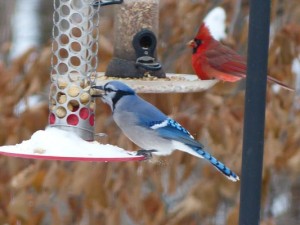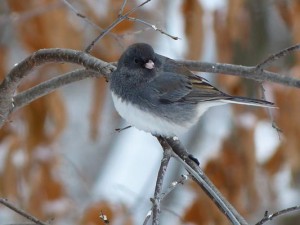Many times people are surprised by some of the birds they can see in their backyard during our harsh winter months. If there are sufficient natural food sources on their breeding grounds even American Robins and Eastern Bluebirds will sometimes remain in the area where they spent the summer.

Our beautiful cardinals will remain with us all winter. It’s wonderful to see the bright red cardinals against a backdrop of winter snow. Our Black-capped Chickadees and White-breasted Nuthatches are with us through the winter. Sometimes we will get an influx of Red-breasted Nuthatches during the winter.
Most of our woodpeckers also stay all winter too. The Downy and Hairy Woodpeckers, the large Pileated, and the Red-bellied Woodpecker can be seen at suet feeders on the coldest of winter days.
American Goldfinches stay in Minnesota all year, and are busy at backyard feeders, but the males lack their bright yellow breeding plumage. As a protection against being seen by predators the goldfinches molt in the fall to an olive drab, the males now closely resembling the females. Because of this dramatic change in color, they can be mistaken for other species and lead some people to the errant conclusion that their goldfinches have left. Feeding goldfinches all winter will ensure that some will stay in your area to nest this spring.
Blue Jay populations shift about in preparation for the winter cold. You will likely have Blue Jays brightening your winter landscape but they may not be the same individuals that were here this summer. Some of these jays will be travelers from northern territories and some of our summer Blue Jays will move a bit south.
House Finches will be here all winter. In fact, most of the raspberry-colored finches we see are male House Finches. The first-year juveniles will likely not be as brightly colored as the older adult males. The plumage of male House Finches can vary greatly, from an orange-y hue to very raspberry.
Brown Creepers are a year-round resident in most of their range, but the northern Minnesota populations do engage in some migratory behavior, moving several hundred miles south to our yards here in the Twin Cities Metro Area. Look for them spiraling up and around tree trunks and limbs as they forage.
Common Redpolls and Pine Siskins are unpredictable and irruptive in their migration patterns. Failures in seed crop production in spruce and other conifers can force the redpolls and Pine Siskins to venture south in search of food. Every few years the redpolls show up in great numbers.

The first Dark-eyed Juncos arrive in late September; the males sporting an executive charcoal gray and white look. Juncos glean seeds and insects from twigs, leaves and the ground cover of leaves on the ground. They are entertaining as they hop forward and kick their feet back scratching the ground for food. Juncos prefer poking around on the ground below feeders but can be attracted to hanging feeders as well. Maintaining a clean water source by using a heated birdbath attracts juncos as well as birds that don’t normally eat at seed feeders.
By Guest Contributor MELISSA BLOCK

